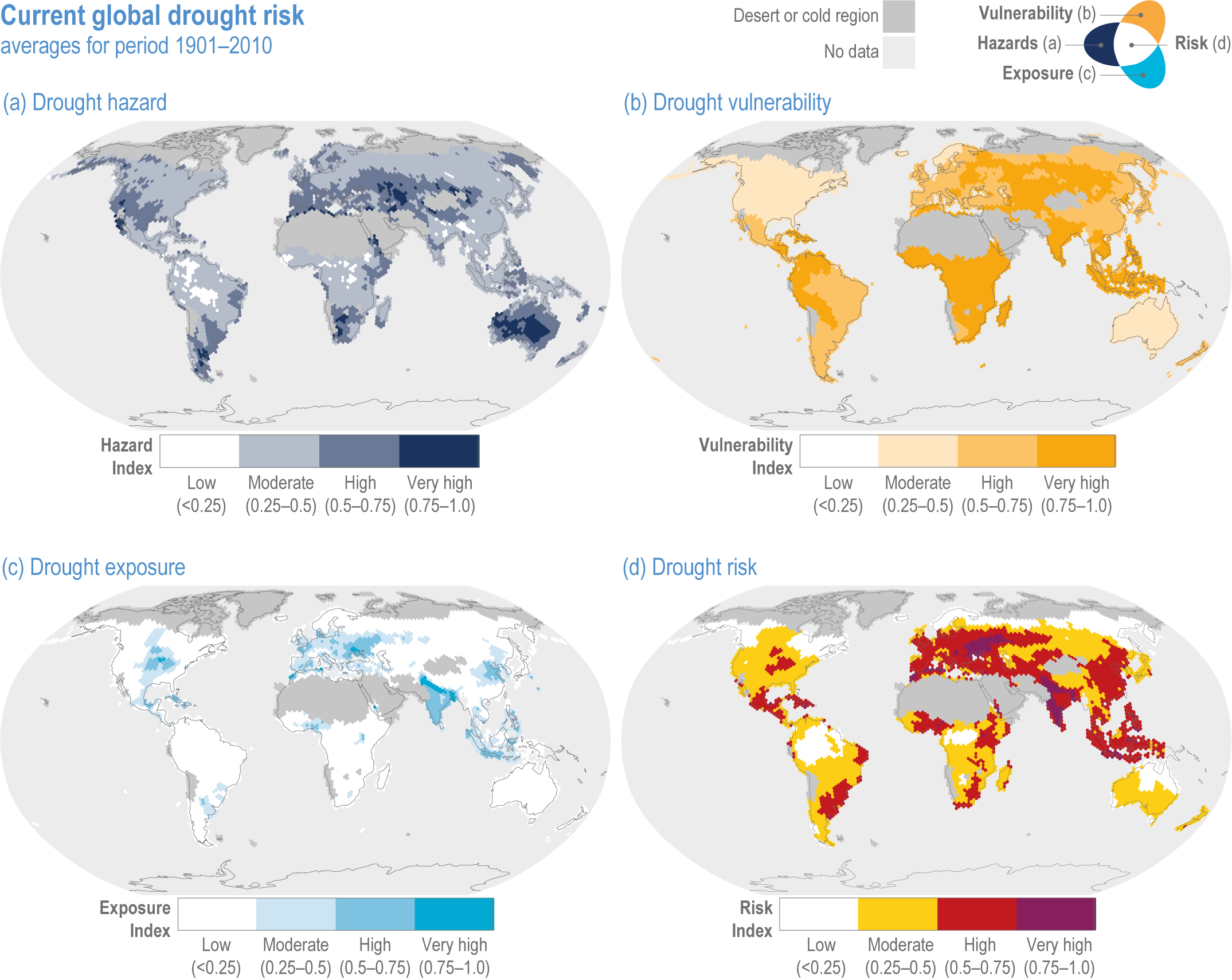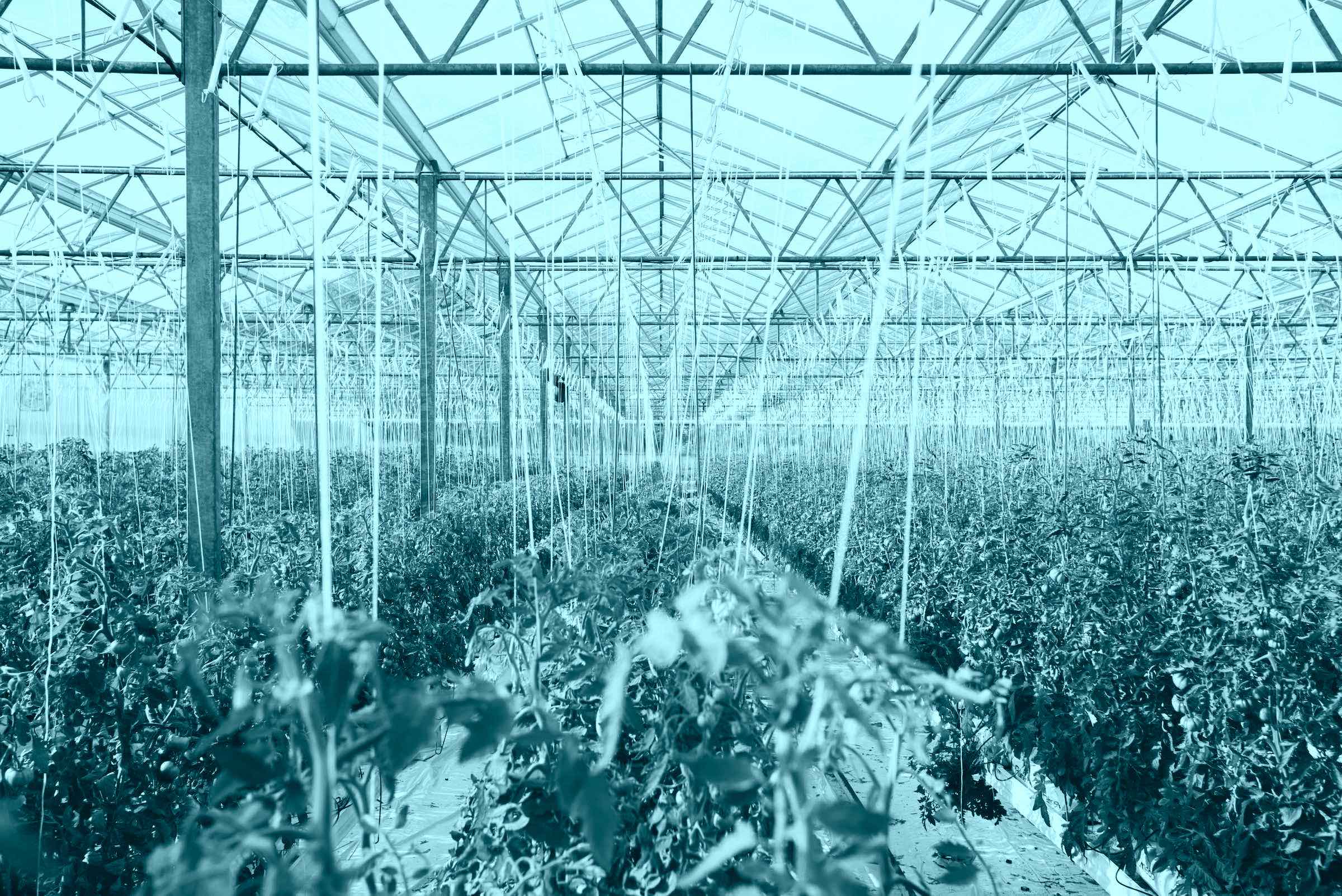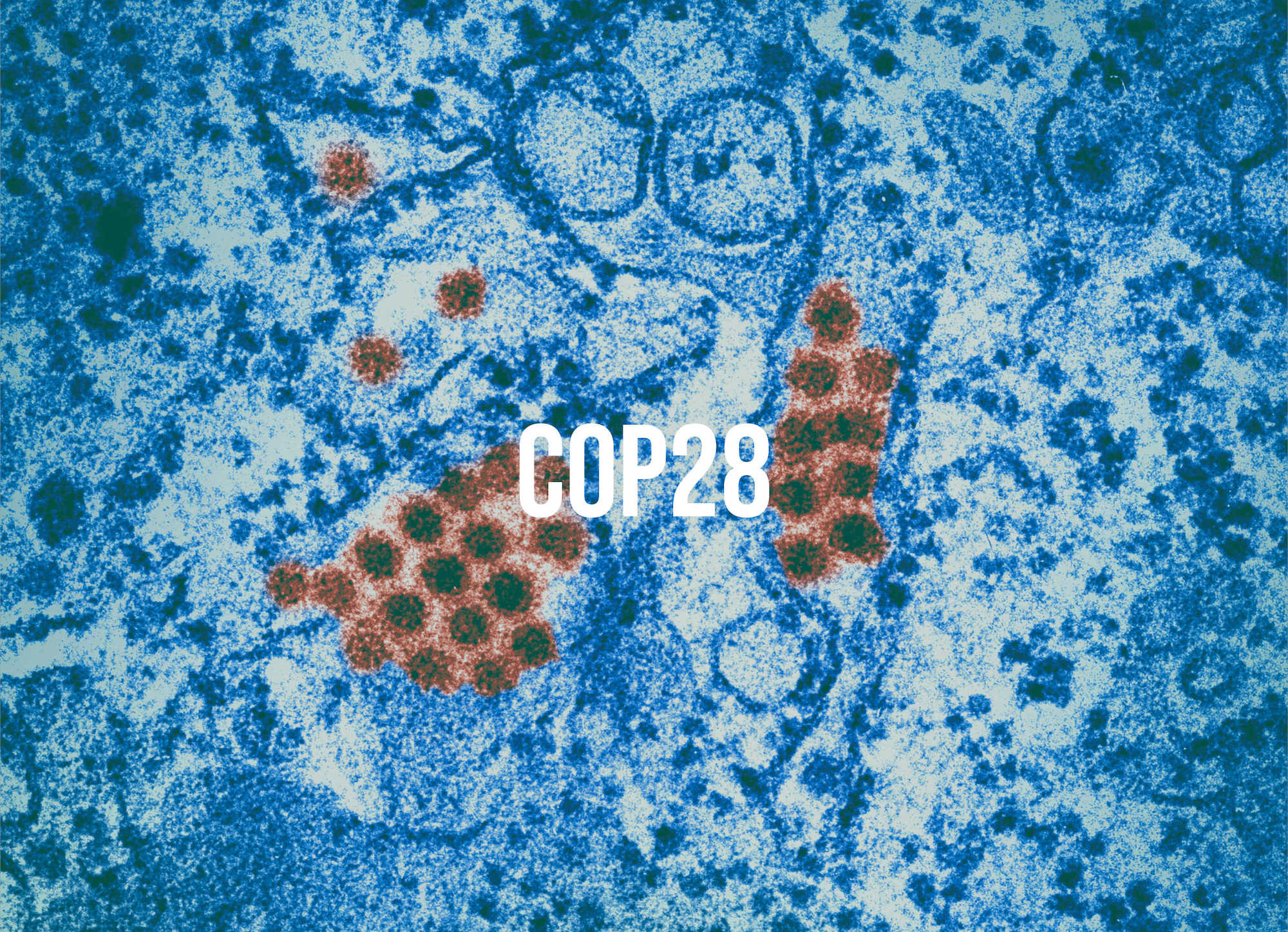Sectors such as agriculture, energy, water supply, and ecosystems are particularly vulnerable to the impacts of drought. Rising global temperatures intensify these impacts, leading to desertification, land degradation, and social instability. Drought is monitored through indicators like precipitation, evapotranspiration, soil moisture, and river flow.
Drought was one of the key elements analyzed and highlighted in the IPCC “Climate Change 2022: Impacts, Adaptation and Vulnerability” report, published in 2022. This report, the Working Group II contribution to the IPCC Sixth Assessment Report (IPCC AR6 WG2 Report), evaluates the consequences of climate change on a global and regional scale, examining the effects on ecosystems, biodiversity, and human communities. It assesses the vulnerabilities and the ability of both the natural world and human societies to adapt to the challenges posed by climate change.

In particular, Chapter 4: Water highlights the documented and predicted alterations in the water cycle caused by climate change, their present effects and potential risks on both human and natural systems, and the advantages and efficacy of adaptation measures pertaining to water resources, both presently and in the years to come.
These of course include drought, pointing out that “currently, roughly half of the world’s ~8 billion people are estimated to experience severe water scarcity for at least some part of the year due to climatic and non-climatic factors.”
“The section on drought, to which I contributed in the context of the IPCC’s Sixth Assessment Report on Climate Change, confirms that water-related risks are one of the most significant components of ongoing climate change impacts,” said Gustavo Naumann of Fondazione CIMA and Contributing Author of the IPCC AR6 WG2 Report to IPCC Italia. “This implies that drought will directly impact the lives and livelihoods of people worldwide, making it a visible and tangible manifestation of climate change experienced by billions of individuals on a daily basis.”
The report’s findings reinforce the relevance of scientific research in providing advanced insights into a topic of paramount importance, aiming to facilitate the necessary changes to address the impacts of climate change. Furthermore, the IPCC report affirms essential principles for achieving successful adaptation, including political agendas on climate change adaptation, initiatives that incorporate direct knowledge from local communities, participatory and inclusive governance, actions rooted in social and gender equity, and adequate financing.
Climate change will lead to populations becoming more vulnerable to floods and droughts due to an increase in the frequency, magnitude and total area affected by water-related disasters. Floods and droughts will also affect more people in the course of this century as a result of population growth and increased urbanisation, especially if warming cannot be limited to 1.5°C. […] droughts can have adverse health impacts due to the limited availability of food and water for drinking and hygienic purposes.
FAQ 4.3, IPCC AR6 WG2
According to the IPCC Report, anthropogenic land use and climate change will intensify floods and droughts, making populations more vulnerable, while higher global warming levels will further amplify these extreme events.
Droughts occur due to reduced precipitation, increased evapotranspiration, and diminished soil moisture, in addition to factors such as snow cover, runoff, and streamflow. Warmer temperatures can increase evapotranspiration, leading to drier soils. Decreased soil moisture reduces river water supply and increases aridity, creating conditions for fires. Additionally, reduced snow cover reduces downstream runoff during warmer seasons.
Meteorological drought refers to a “period with an abnormal precipitation deficit”. According to the IPCC definition, droughts can be hydrological, agricultural, or ecological, depending on processes and their propagation to other systems, or sectors being impacted. Precipitation deficit can negatively affect crop production or ecosystems, causing a shortage of soil moisture and producing what can be defined as agricultural drought, while ecological drought is related to plant water stress that for instance can cause tree mortality.
Finally, hydrological drought occurs when “the runoff and percolation season primarily affects water supplies,” with water shortage in lakes, lagoons, or groundwater.
Projections indicate increased agricultural drought likelihood in southern Africa, Australia, Europe, the southern and western USA, Central America, the Caribbean, northwest China, parts of South America, and the Russian Federation. Conversely, southeastern South America, central Africa, central Canada, western India, and the southern Arabian Peninsula are projected to experience a decline in agricultural drought due to increased precipitation.
What has changed
To assess the global drought risk, hazard, vulnerability and exposure need to be considered jointly. The IPCC Report shows that “drought risk is lower for sparsely populated regions, such as tundra and tropical forests, and higher for populated areas and intensive crop and livestock farming regions, such as southern and central Asia, southeastern South America, central Europe and the southeastern USA.”
An increase in drought-related risks is expected globally due to the combined effects of extreme weather events and population exposure. Studies indicate that water-related impacts are projected to surpass the adaptation measures currently in place, posing significant socioeconomic and environmental risks.
Long-term analyses reveal substantial increases in drought risk across all scenarios, with a particularly notable rise in the Mediterranean region.
Concerning prolonged periods of drought, there is a risk of irreversible aridity, especially under higher levels of global warming. “In Europe, for example, this aridity condition would affect a growing portion of the population,” said Naumann. “With a warming of 3°C above pre-industrial levels, an estimated 170 million people would experience extreme drought. By limiting the warming to 1.5°C, the population exposed to such conditions would decrease to 120 million. […] The impacts of drought are intensified by their diverse effects across different sectors, including rivers, watercourses, agriculture, electricity production, industry, as well as significant implications for GDP and welfare.”

Severe drought events globally have caused significant societal and ecological consequences, such as reduced crop yields, water shortages, wildfires resulting in human and animal fatalities, and detrimental effects on the habitats of endangered species. These events have also led to extensive economic losses.
Furthermore, attribution analyses showed that anthropogenic warming and climate change has increased the likelihood or severity of most drought events. The work of the WG1 highlighted for example that agricultural/ecological droughts over the last decades in the Mediterranean and western North America have been more frequent and severe as a consequence of anthropogenic warming.
What will change
The IPCC foresees – with high confidence – that “more regions are affected by increases in agricultural and ecological droughts with increasing global warming”, and that in the future “the total land area subject to increasing drought frequency and severity would expand”.
Changes will be more evident in three specific areas, i.e., the Mediterranean, southwestern South America, and western North America, where future aridification is expected to greatly exceed the magnitude of change seen in the last millennium.
The Report reviews different studies and their results, with relative uncertainties, highlighting the importance of considering multiple factors, such as precipitation, soil moisture, and runoff, in assessing drought impacts. It also emphasizes how “the choice of drought definition (e.g., agricultural, meteorological) can affect the magnitude and even the sign of the projected drought change,” therefore it is essential to consider the type of drought when applying drought projections to impact and risk in decision-making, especially in adaptation and mitigation strategies.

Drought risk prediction is a complex phenomenon, and is affected by other uncertainties, in addition to the ones influenced by the choice of drought definition considered.
For example, “drought projections are subject to uncertainties due to limits of predictability and understanding of the relevant biophysical processes,” the IPCC Report says. Uncertainties also exist in regional climate changes and the range of regional outcomes generally increases with global warming, contributing to the range of outcomes and increased likelihood of extreme droughts.
The likelihood of drought is projected to increase in many regions over the 21st century (high confidence) even with strong climate change mitigation, and more severely in the absence of this. […] the frequency of agricultural drought is projected to increase over wider areas than for meteorological drought (medium confidence). Clarity on the definition of drought is therefore important for informing decision-making. With the RCP6.0 and SSP2 scenarios, the global population exposed to extreme-to-exceptional terrestrial water storage drought is projected to increase from 3% to 8% over the 21st century.
Chapter 4, IPCC AR6 WG2
Besides weighting up uncertainties, it is crucial to consider that the effects of drought are not immediately visible but could be observed up to several months later (for example in agriculture or forestry). At the same time, the continuous evolution of meteorological and climatic phenomena highlights the importance of having comprehensive and up-to-date scientific knowledge, enabling the implementation of strategies that mitigate the risks and effects of drought.
“The IPCC report emphasizes some fundamental principles for achieving successful adaptation,” says Naumann, “such as: having a political agenda for climate change adaptation, taking local community knowledge into account, fostering participatory and inclusive governance, implementing actions based on social and gender equity, and ensuring adequate financing.”
Credits:
- Figure 1: FAQ 8.3 Figure 1 in IPCC, 2021: Chapter 8. In: Climate Change 2021: The Physical Science Basis. Contribution of Working Group I to the Sixth Assessment Report of the Intergovernmental Panel on Climate Change [D]ouville, H., K. Raghavan, J. Renwick, R.P. Allan, P.A. Arias, M. Barlow, R. Cerezo-Mota, A. Cherchi, T.Y. Gan, J. Gergis, D. Jiang, A. Khan, W. Pokam Mba, D. Rosenfeld, J. Tierney, and O. Zolina, 2021: Water Cycle Changes. In Climate Change 2021: The Physical Science Basis. Contribution of Working Group I to the Sixth Assessment Report of the Intergovernmental Panel on Climate Change [Masson-Delmotte, V., P. Zhai, A. Pirani, S.L. Connors, C. Péan, S. Berger, N. Caud, Y. Chen, L. Goldfarb, M.I. Gomis, M. Huang, K. Leitzell, E. Lonnoy, J.B.R. Matthews, T.K. Maycock, T. Waterfield, O. Yelekçi, R. Yu, and B. Zhou (eds.)]. Cambridge University Press, Cambridge, United Kingdom and New York, NY, USA, pp. 1055–1210, doi: 10.1017/9781009157896.010 .]
- Figure 2: Figure 4.9 in Caretta, M.A., A. Mukherji, M. Arfanuzzaman, R.A. Betts, A. Gelfan, Y. Hirabayashi, T.K. Lissner, J. Liu, E. Lopez Gunn, R. Morgan, S. Mwanga, and S. Supratid, 2022: Water. In: Climate Change 2022: Impacts, Adaptation, and Vulnerability. Contribution of Working Group II to the Sixth Assessment Report of the Intergovernmental Panel on Climate Change [H.-O. Pörtner, D.C. Roberts, M. Tignor, E.S. Poloczanska, K. Mintenbeck, A. Alegría, M. Craig, S. Langsdorf, S. Löschke, V. Möller, A. Okem, B. Rama (eds.)]. Cambridge University Press, Cambridge, UK and New York, NY, USA, pp. 551-712, doi:10.1017/9781009325844.006.
- Figure 3: Figure 4.18 in Caretta, M.A., A. Mukherji, M. Arfanuzzaman, R.A. Betts, A. Gelfan, Y. Hirabayashi, T.K. Lissner, J. Liu, E. Lopez Gunn, R. Morgan, S. Mwanga, and S. Supratid, 2022: Water. In: Climate Change 2022: Impacts, Adaptation, and Vulnerability. Contribution of Working Group II to the Sixth Assessment Report of the Intergovernmental Panel on Climate Change [H.-O. Pörtner, D.C. Roberts, M. Tignor, E.S. Poloczanska, K. Mintenbeck, A. Alegría, M. Craig, S. Langsdorf, S. Löschke, V. Möller, A. Okem, B. Rama (eds.)]. Cambridge University Press, Cambridge, UK and New York, NY, USA, pp. 551-712, doi:10.1017/9781009325844.006.






